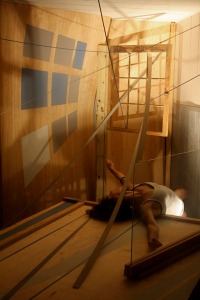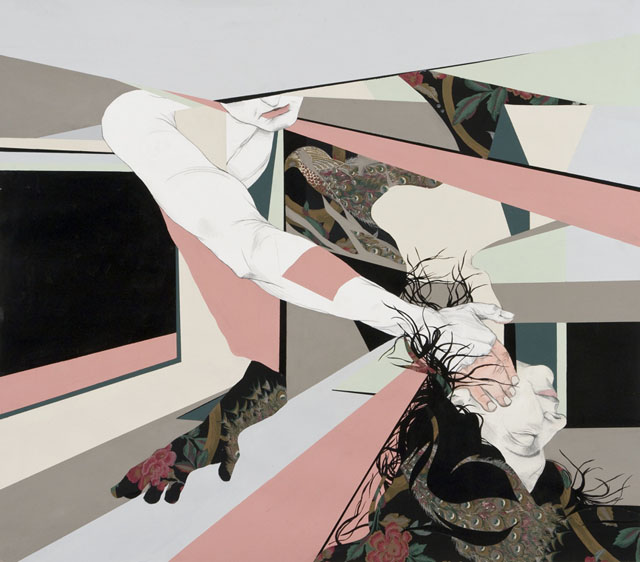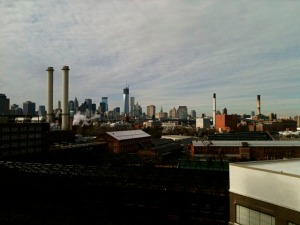
Excerpt from “99 Lines,” 2011, site specific installation/ 4-hour durational performance
Briefly describe the work that you do.
The center of my work is drawing. Generally, within the drawings an architecturally based space is constructed through line and flat areas of color. The space that is created is then either occupied by the figure or is explicitly absent of it. When the body is present in a drawing it is both supported and interrupted by the structure it occupies producing an interdependent relationship between body and architecture. The two central elements work to express intangible conditions of being. These concepts naturally extend out into sculpture that is usually generated in part from architectural cast-offs, allowing the viewer to take the role of figure in the work. And in the last four years, I have begun working with my partner, artist and dancer Dillon Paul, who brings a very different perspective and approach to the figure in space. Our ongoing collaboration, “Movement + Stillness,” has enabled me to move my work into the realms of video and performance installation while also opening up my individual practice in the studio.
At what point in your life did you decide to become an artist?
Like so many of us makers I was always “the artist” in my family. As a kid this began with the influence of my mother who applied her own art practice to her work as a Montessori school teacher and, as a mother, was committed to taking her two daughters to museums, theater, galleries, etc. As an adult there have been a series of moments where I have been called to a kind of confirmation, a sort of statement of faith in continuing my own practice. In terms of a specific moment of knowing… When I was eight I saw “Excavation” by DeKooning and literally fell on the floor. I remember very clearly knowing that I wanted to do whatever he had done to make me feel so much.
Tell us a little about your background and how that influences you as an artist.
I was born and raised just outside of Detroit’s city limits. The visual and visceral power of that city is a very real thing. And when you are raised with consistent exposure to this place, full of dying streets, the residue of past grandness, and buildings now empty except for all of the memories they hold you cannot help but be influenced. It set up a love for architecture in me and it made buildings feel like people with a past – palpable sadness, hopes, loss, potential, stories that can only be uncovered through the investment of time.
When I was a teenager, I trespassed… a lot. Being alone in spaces so vast, often so unstable, surrounded by debri and mystery, the fear in that, the ability to connect in that… spaces that embody both strength and vulnerability and by occupying them you have a heightened awareness of those two qualities in yourself as well.
A specific memory I have from when I was quite small is standing outside of the Masonic Temple downtown and looking across the street at a home that had been burned out. I could see straight through to the back stairwell where three saplings grew, each on their own step. There are a million stories you could write, or paint, about images like that. A house, opened up to the sky and the elements. You can easily put yourself inside of a space like that.

“Press,” 2013, graphite and acrylic on paper, 38 x 50″
What types of conceptual concerns are present in your work? How do those relate to the specific process(es) or media you use?
My work examines the relationship between architecture and the body, whether constructed or felt. It explores the ways we build and occupy space through memory, perspective, relationship and psycho-dynamics. When drawing, figure, surface, lines, geometry and color interrupt and support one another. Within three-dimensional space, objects and architectural surrounds are constructed to promote a physical and evocative connection with the body of the performer and/or the viewer. The work is not about representing a location but instead about presenting what is found there. Intersecting lines, partial views and planes of dislocated material produce windows into an experienced place.
We once heard Chuck Close say he did not believe in being inspired, rather in working hard everyday. What motivates you in your studio practice?
I am motivated by fear. Joking… sort of.
I am a Midwestern gal at heart. I like work. I don’t feel good if I am not working. I find that if I take care of my work it takes care of me. If I show up for it, prove its value by spending time, I always have it even when I have had very little else. And it is a tangible thing. You do have to pay attention, feed yourself with information outside of the studio to keep the practice moving. For me those things tend to be architecture, music, watching dance or film, and reading even more than looking at others work (though looking is very important). And those outside influences help keep your mind going, especially in the moments where self-generating ideas is more challenging. But for me the most important aspect of maintaining a studio practice is simply consistently putting physically yourself in the space to work in order for the act of making to be possible. Inspiration is more often found, from my perspective, on the backside of making. In terms of the fear part… I have a healthy anxiety about working to meet my potential with the time I have.
What artists living or non-living influence your work?
Julie Mehretu, Gordon Matta Clark, Helena Almeida, Swoon, Margaret Kilgallen, Agnes Martin, Willem DeKooning, Doris Salcedo, Arakawa/ Gins, Louise Bourgeois, Martin Puryear, the films of Julian Schnabel, Wim Wenders… just to name a few…

“It’s Not My Fault (I Grew Up in the Suburbs),” 2013, concrete, cabinet face, Synlawn, wallpaper
When you are not making art what types of activities and interests do you engage in?
We have a four year old daughter so time with my family is very important. I love to cook for them, make the house beautiful, draw with her, have dance parties… and through our daughter I have a constant reminder about the importance of play. As I mentioned before, I am also big on music, seeing dance and performance, I have a deep love of documentaries…
I am also the Assistant Director of International Admissions at Pratt Institute. So when I am not in my studio I am able to spend time discussing the act of making with young artists and designers from all over the world. Through this position, I have traveled to eleven countries in the last year, which is an opportunity I feel very grateful for and one that provides exposure to sights and smells and interactions that you cannot help but be influenced by.
 About
About
Lindsey A. Wolkowicz was born in 1981 and raised in the Detroit area. She moved to Milwaukee, WI to attend Milwaukee Institute of Art & Design where she received her BFA in Painting. Wolkowicz remained in Milwaukee until 2007 as an active participant in the arts community then, after a year long stint in Portland, Oregon, moved to Brooklyn, NY. She completed her MFA in Painting/ Drawing at Pratt Institute in 2009 where she now works as the Assistant Director of International Admissions. Wolkowicz has exhibited nationally/ internationally and, in the coming year, will be a participating artist in the Dashboard Co-Op in Atlanta, GA. Wolkowicz lives in Brooklyn, NY with her partner/ collaborator Dillon Paul and their daughter Maeve and continues to make work in her studio in the Brooklyn Navy Yard.

View from Lindsey’s studio
All images copyright of the artist and used with their permission.
